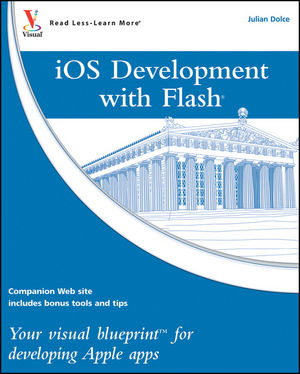iOS Development with Flash: Your visual blueprint for developing Apple appsISBN: 978-0-470-62204-9
Paperback
352 pages
December 2010
 This title is out-of-print and not currently available for purchase from this site.
|
Introducing the iPhone and iPod touch.
Introducing the Development Tools.
Introducing the Available APIs.
Check What APIs Are Not Available.
Become an iPhone Developer.
Generate a Certificate Signing Request on Mac OS X.
Generate a Certificate Signing Request in Windows.
Upload Your Certificate Signing Request.
Create a P12 Certificate on Mac OS X.
Create a P12 Certificate in Windows.
Add Devices to Your Account.
Create App IDs.
Create a Provisioning Profile.
Add Provisioning Files to Your Device.
2 GETTING STARTED WITH FLASH CS5.
Using the Actions Panel.
Create a Skeleton Custom Class.
Set the Source Path.
Create MovieClips.
Create Buttons.
Edit Properties in Flash.
Add Objects to the Stage with Code.
Remove Objects from the Stage with Code.
Work with Events.
Using the Drawing API.
Using Flash CS5 Help.
3 DEVELOPING YOUR FIRST APPLICATION.
Create a New Project.
Configure Publish Settings.
Set Your Application Output.
Add Your iPhone Certificate.
Add Your Provisioning File.
Compile from Flash Professional CS5.
Compile from the Command Line.
Install Your Application with the iPhone Configuration Utility.
Install Your Application with Xcode.
Update Your Version Number.
4 DESIGNING YOUR APPLICATION.
Explore Apple’s Human Interface Guidelines.
Understanding Screen Resolutions.
Create Full-Screen Applications.
Understanding Screen Orientation.
Create Usable Hit States.
Understanding Layout.
Change the Status Bar Style.
5 HANDLING INTERACTION.
Create Button States.
Respond to Touch Events.
Track Multiple Touches.
Respond to Zoom Events.
Respond to Rotate Events.
Respond to Pan Events.
Respond to Swipe Events.
Listen for Accelerometer Events.
Determine If the Accelerometer Is Available.
Determine Device Orientation.
Detect Which Way Is Up.
Filter Accelerometer Data.
6 WORKING WITH IMAGES.
Prepare Your Images.
Import Images.
Display Images.
Bundle Images with Your Application.
Load Images at Runtime.
Create Images Dynamically.
Save Images to the Photo Library.
Load Images from the Photo Library.
Using iOS Default Images.
7 WORKING WITH SOUND.
Import Audio into Your Project.
Choose an Audio Codec.
Bundle Sounds with Your Application.
Load Sounds at Runtime.
Play Sounds.
Stop Sounds.
Set the Volume of a Sound.
Visualize the Sound Spectrum.
8 WORKING WITH VIDEO.
Explore Available Video Formats and Encode a Video File.
Convert Videos.
Embed a Video.
Bundle a Video with Your Application.
Load a Video.
Buffer a Video.
Control a Video.
Set the Volume of a Video.
9 WORKING WITH TEXT.
Determine Available Fonts on Your Device.
Embed Fonts in Your Application.
Create an Input TextField.
Create a Password TextField.
Using TLF TextFields.
Create a Scrollable TextField.
10 SAVING STATE.
Create a Local SharedObject.
Write to a SharedObject.
Load Data from a SharedObject.
Connect to a SQLite Database.
Create a SQLite Table.
Insert Data into a SQLite Table.
Select Data from a SQLite Table.
Update Data in a SQLite Table.
Delete Data from a SQLite Table.
Handle Application Exits.
Save Application States.
11 WORKING WITH FILES.
Reference Files and Directories.
Write Files.
Read Files.
Update Files.
Append Files.
Handle Files Synchronously.
Copy Files.
12 USING THE LOCATION, CONTACTS, AND WIFI FEATURES.
Retrieve Your Current Location.
Map Your Location.
Determine Your Speed.
Retrieve a List of Contacts.
Retrieve a Contact's Details.
Retrieve Phone Number Favorites.
Check for an Internet Connection.
Check for a Persistent WiFi Connection.
Set the System Idle Mode.
13 USING SPECIAL IPHONE URL PROTOCOLS.
Make Phone Calls.
Open the Mail Application.
Open the Maps Application.
Open the Messages Application.
Play a YouTube Video.
Open the iTunes Store.
14 INTEGRATING WITH THIRD-PARTY SERVICES.
Submit Updates to Twitter.
Display Ads with Smaato.
Track with Google Analytics.
Display Ads with AdMob.
15 OPTIMIZING PERFORMANCE.
Optimize Your Display List.
Manage Mouse Events.
Understanding cacheAsBitmap.
Understanding cacheAsBitmapMatrix.
Determine the Device OS.
16 CREATING APPLICATION SETTINGS.
Create a Settings Bundle.
Add a Settings Group.
Add a Text Setting.
Add a Multiple Value Settings Field.
Add a Toggle Switch Field.
Add a Slider Settings Field.
Add a Title Settings Field.
Add the Settings Bundle to Your Application.
Read the Settings.
Add an Icon to Your Settings.
Read Your Device’s Global Settings.
17 DEBUGGING YOUR APPLICATION.
Show Your Trace Statements.
Create Breakpoints.
Using the Flash CS5 Debugger.
Understanding the Debug Console.
Understanding the Variables Panel.
Get Crash Reports.
Using Instruments.
Using the ObjectAlloc Instrument.
Using the Core Animation Instrument.
Using the OpenGL ES Instrument.
Using the Activity Monitor Instrument.
Using the Hardware Acceleration Profiler.
18 DEPLOYING YOUR APPLICATION.
Create an Application Icon.
Remove the Glare from Your Application Icon.
Create a Default Splash Screen.
Create App Store Graphics.
Create a Distribution Certificate.
Create an Ad Hoc Provisioning File.
Publish for Ad Hoc Distribution.
Create an App Store Provisioning File.
Publish Your Application for App Store Distribution.
Submit Your Application to the App Store.
Getting Your App Approved.
Track Your Application Sales.
INDEX.



